Science Olympiad Previous Year Paper - 1 | Science Olympiad Class 6 PDF Download
Note: The questions provided in this document are similar to the questions that were asked in the actual Olympiad exam. So, we recommend you study these for your Olympiad preparation.
Logical Reasoning
Q1: If LINGER is coded as !@#$%& and ANGER is coded as *#$%&, then how will you code GINGER?(a) $@#$%&
(b) !@#$%&
(c) !@#$%
(d) $#$%&
 View Answer
View Answer 
Ans: (a)
The code of different letters is given below as:
L - !
I - @
N - #
G - $
E - %
R - &
Similarly, we can find out the code for GINGER.
GINGER = $@#$%&
Q2: If Krisha works 2400 minutes per week, find the total time (in hours) she will work in 4 weeks.
(a) 160 hours
(b) 150 hours
(c) 60 hours
(d) 16 hours
 View Answer
View Answer 
Ans: (a)
In one week, she works 2400 minutes.
In 4 weeks, time taken by her = 2400 x 4 = 9600 minutes
To find the answer in hours, we will divide 9600 by 60, (1 hour = 60 minutes).
9600/60 = 160 hours
Q3: A man walks 6 km toward south and then turns to the right. After walking 3 km he turns to the left and walks 5 km. Now in which direction is he from the starting place?
(a) West
(b) South-West
(c) North-East
(d) South
 View Answer
View Answer 
Ans: (b) Hence required direction is South-West.
Hence required direction is South-West.
Q4: Choose the term that will come in place of the question mark (?) in the given relationship.
ABC : CDE : : MNO : ?
(a) POQ
(b) OPO
(c) OPQ
(d) OOQ
 View Answer
View Answer 
Ans: (c)
Every next letter for the corresponding term is obtained after getting two jumps in the original term.
A + 2 = C
B + 2 = D
C + 2 = E
Similarly,
M + 2 = O
N + 2 = P
O + 2 = Q
Q5: A is the father of B and C is the mother of D. M is the paternal uncle of D. If B and D are siblings, then how is M related to A?
(a) Father
(b) Brother
(c) Uncle
(d) Son
 View Answer
View Answer 
Ans: (b)
B and D are siblings, so A and C are husband and wife.
M is the paternal uncle of D and hence, the brother of D's father, who is A.
Q6: Pointing to a girl in the picture, Vansh said, "She is the daughter of my father's brother". How is that girl related to Vansh?
(a) Sister
(b) Mother
(c) Cousin
(d) Niece
 View Answer
View Answer 
Ans: (c)
- Vansh's father's brother is his uncle.
- The girl mentioned is the daughter of that uncle.
- This makes her Vansh's cousin.
- Thus, the correct relationship is that she is Vansh's cousin.
Q7: Five boys are sitting in a restaurant bench. Mohan is to the left of John and to the right of Inder. Jack is to the right of John. Raman is between John and Jack.
Who is sitting second to the right of Mohan?
(a) Raman
(b) John
(c) Jack
(d) Inder
 View Answer
View Answer 
Ans: (a)
Inder, Mohan, John, Raman, Jack
From the given arrangement, Raman is sitting second to the right of Mohan.
Q8: If 'P' represents 'x', 'Q' represents ‘+', ‘R’ represents '÷' and ‘S’ represents '-', what is the result of 34 P 2 Q 14 R 7 S 8?
(a) 64
(b) 63
(c) 62
(d) 60
 View Answer
View Answer 
Ans: (c)
- First, we replace the symbols: 34 P 2 Q 14 R 7 S 8 becomes 34 x 2 + 14 ÷ 7 - 8.
- Next, we perform the calculations in the correct order: 34 x 2 equals 68.
- Then, 14 ÷ 7 equals 2.
- Now, we combine these results: 68 + 2 - 8 equals 62.
Q9: Rearrange the following letters to make a single word and then choose the category to which it belongs:
Y L A T I
(a) Country
(b) Ocean
(c) City
(d) Mountain
 View Answer
View Answer 
Ans: (a)
After rearranging the given letters, we get
Y L A T I = I T A L Y; which is a country.
Q10: Shreya is facing South-West. She wants to go to her friend’s house, so she turns through 135° in a clockwise direction. In which direction is she facing now?
(a) North-West
(b) South-East
(c) North
(d) South
 View Answer
View Answer 
Ans: (c)
- Shreya starts facing South-West.
- When she turns 135° clockwise, she moves through the following directions:
- From South-West to South (45°) and then from South to South-East (another 45°), totaling 90°.
- Finally, she turns another 45° to reach North.
- Thus, after the turn, she is now facing North.
Science Section
Q11: The seed dispersal in the given plant takes place by_________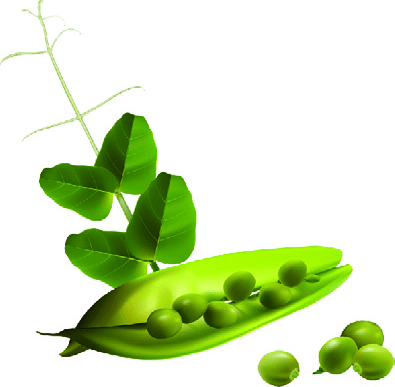 (a) Wind
(a) Wind
(b) Animal
(c) Explosion
d) Water
 View Answer
View Answer 
Ans: (c)
The given figure is of a pea plant. In pea plant, the seed dispersal takes place by explosion.
Q12: Plants growing in deserts, as shown in the figure have spines instead of leaves. Then, how do these plants make food in the absence of leaves?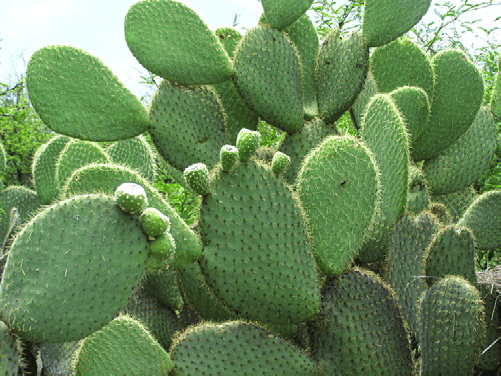
(a) Spines themselves make food.
(b) Roots make food.
(c) Green, fleshy stem makes food.
(d) Flowers make food.
 View Answer
View Answer 
Ans: (c)
In desert plants like cactus, the green fleshy stem makes and stores food.
Q13: Latika cut away the outer ring of the stem of a plant as shown. The cross section of the stem, W–X, is shown. What would possibly be Latika observation after a week?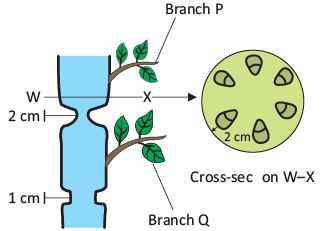 (a) Branch P would die.
(a) Branch P would die.
(b) Branch Q would die.
(c) Both the branches P and Q would die.
(d) Both branches P and Q would survive.
 View Answer
View Answer 
Ans: (a)
Branch P would die.
Q14: The figure shows the leaf of a plant. Identify the process.
Identify the process.
(a) Dispersal of seed
(b) Vegetative propagation
(c) Defecation
(d) Nutrition
 View Answer
View Answer 
Ans: (b)
The given figure is that of a Bryophyllum leaf. It reproduces from leaf buds that are developed on the margin of it. The process by which new plants are grown from the parts of the plant other than seed is called vegetative propagation.
Q15: Which of these belongs to the centre ?
(a) Things that cover animal bodies.
(b) Things that help animal bodies get oxygen.
(c) Things that make the animal smaller.
(d) Things that keep animal bodies cool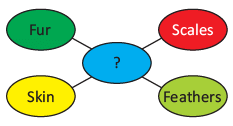
 View Answer
View Answer 
Ans: (a)
Thing that cover animals bodies are fur, scales, skin and feathers.
Q16: Which of the following body organs is responsible for cleansing our blood ?
(a) 
(b) 
(c) 
(d) 
 View Answer
View Answer 
Ans: (b)
Organs shown in (b) is kidneys, which is responsible for cleansing our blood.
Q17: Choose the incorrect statement?
(a) Air is not a matter
(b) Atom is smallest amount
(c) Molecules in solids are closely packed
(d) Matter is made up of atom and molecules
 View Answer
View Answer 
Ans: (a)
Air is a matter.
Q18: In a large forest with many kinds of animals, there is only a small number of bears. Which of these most likely limits the population of bears in the forest?
(a) Supply of food
(b) Type of tree
(c) Predation by carnivores
(d) Amount of suitable shelter
 View Answer
View Answer 
Ans: (a)
The supply of food limits the population of bears in the forest.
Q19: Match the following.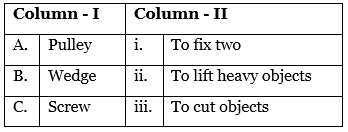 (a) A-ii, B-i, C-iii
(a) A-ii, B-i, C-iii
(b) A-ii, B-iii, C-i
(c) A-i, B-iii, C-ii
(d) A-iii, B-i, C-ii
 View Answer
View Answer 
Ans: (b)
Pulley is used for lifting heavy objects, wedge is used for cutting objects and screw is used for fixing two objects.
Q20: We are able to stand upright because
(a) We do not have a tail.
(b) Our backbone holds the body vertically up.
(c) We only have two legs.
(d) Our head bones are light.
 View Answer
View Answer 
Ans: (b)
We are able to stand upright because our backbone holds the body vertically up. Backbone is also called as vertebral column. It is a hollow tube through which protects the spinal cord.
Q21: Zoya, a sixth-grade student, categorized several items based on shared characteristics as follows: Group I: Plastic bottle, balloon, ice, wooden log Group II: Food color, vinegar, lemon juice, chalk powder Group III: Clean water, glass window, lens, air Group IV: Metal key, marble, copper coin, iron nail Identify the incorrect statement about these groups.
(a) All substances listed in group I float on water.
(b) All substances listed in group II are soluble in water.
(c) All substances listed in group III are transparent.
(d) All substances listed in group IV sink in water.
 View Answer
View Answer 
Ans: (b)
- Food color, vinegar, and lemon juice dissolve in water, making them soluble.
- However, chalk powder does not dissolve in water, which makes the statement incorrect.
- Thus, not all substances in Group II are soluble.
- This highlights the importance of understanding the properties of different substances.
Q22: Which of the following describes a chemical change?
(a) Melting of ice
(b) Rusting of iron
(c) Boiling of water
(d) Cutting of wood
 View Answer
View Answer 
Ans: (b)
- Rusting of iron is a process where iron reacts with oxygen and moisture, forming rust, which is a new substance. This is a chemical change because it alters the chemical composition of the iron.
- In contrast, the melting of ice, boiling of water, and cutting of wood are all physical changes, meaning they do not change the chemical structure of the substances involved.
- Additionally, rusting is irreversible, as you cannot easily convert rust back into iron.
Q23: Select the accurate statements about the substances mentioned in the box: Carbon, Soil, Diamond, Carbon dioxide, Water, Mercury, Smoke
(a) I: Carbon dioxide and mercury are compounds.
(b) II: Smoke and soil are heterogeneous mixtures.
(c) III: Water and diamond are homogeneous mixtures.
(d) IV: Mercury and carbon are elements.
 View Answer
View Answer 
Ans: (d)
- Carbon dioxide is indeed a compound, while carbon and mercury are classified as elements.
- Smoke and soil are examples of heterogeneous mixtures, meaning their components are not uniformly distributed.
- On the other hand, water is a compound and diamond is a form of carbon, not a mixture.
- Thus, the correct statements are those that affirm that mercury and carbon are elements, making option IV correct.
Q24: The seed dispersal in the given plant takes place by________ .
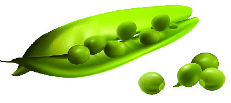 (a) Wind
(a) Wind
(b) Animal
(c) Explosion
(d) Water
 View Answer
View Answer 
Ans: (c)
The given figure is of a pea plant. In pea plant, the seed dispersal takes place by explosion.
Q25: There is some water in a glass. If all the water is poured into an open hot bowl from the glass.
 (a) Volume of water will change.
(a) Volume of water will change.
(b) Shape of water will change.
(c) Surface area of water will increase.
(d) Both (b) and (c)
 View Answer
View Answer 
Ans: (d)
When water is poured from a glass into an open hot bowl, the shape of the water changes as it takes the shape of the new container. Additionally, the surface area of the water increases because an open bowl typically has a wider surface area compared to a glass.
Q26: Classify the given crops Rabi as (R) and Kharif as (K).
(i) Wheat
(ii) Maize
(iii) Bajra
(iv) Gram
(a) (i) - R, (ii) - K, (iii) - K, (iv) - R
(b) (i) - K, (ii) - K, (iii) - K, (iv) - R
(c) (i) - R, (ii) - R, (iii) - K, (iv) - K
(d) (i) - K, (ii) - K, (iii) - R, (iv) - R
 View Answer
View Answer 
Ans: (a)
Wheat and Gram are rabi crops while Bajra and Maize are kharif crops
Q27: The given diagram shows the life cycle of a plant.
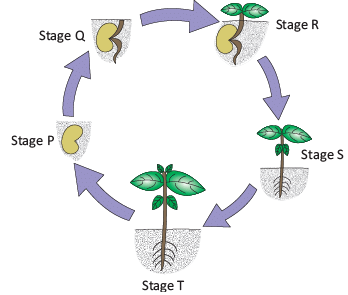 Which o f the following statements is true regarding it?
Which o f the following statements is true regarding it?
I. Sunlight is not needed at stage Q.
II. Photosynthesis takes place only at stages R and S.
III. Stage P is not affected by what happens at stage T.
IV. Stage P needs air, water and warmth to reach stage Q.
(a) I and IV only
(b) II and III only
(c) I, II and III only
(d) All of these
 View Answer
View Answer 
Ans: (a)
Photosynthesis will occur at the stages R, S and T. Stage P is affected by what happens at stage T, because stage T ultimately will give rise to stage P (seed).
Q28: Shubham described the characteristics of three materials as follows: P: Elastic, opaque, non-edible Q: Liquid, inflammable, edible R: Hard, floats on water, inflammable
(a) Plastic, milk, and iron nail
(b) Sand, honey, and soap
(c) Rubber band, cooking oil, and matchstick
(d) Aluminum foil, shampoo, and steel plate
 View Answer
View Answer 
Ans: (c)
- Rubber band is elastic and opaque, making it fit the description of P.
- Cooking oil is a liquid and is edible, matching the properties of Q.
- Matchstick is hard, can float on water when not ignited, and is inflammable, aligning with R.
Q29: Siya cut a piece from a potato with an ‘eye’ or bud, with shoots growing from it. She put it in a pot containing soil, kept this in the sunlight and watered it regularly. She soon saw a potato plant growing from it. The conclusion drawn from the experiment is:
(a) Potato is an underground stem.
(b) In many plants, reproduction takes place through vegetative parts like root, stem and leaves.
(c) Plants needs sunlight and water to grow.
(d) In many plants, reproduction takes place through seeds.
 View Answer
View Answer 
Ans: (b)
Some plants reproduce through their body parts such as stems, leaves or roots. Potato is an underground stem that has buds known as eyes. These buds can grow into new plants.
Q30: Read the following sentence and choose the option that accurately identifies L and M. L is abundant in iodine while M is abundant in phosphorus.
(a) Sea food - Meat
(b) Milk - Cereals
(c) Brinjal - Iodized salt
(d) Pulses - Milk
 View Answer
View Answer 
Ans: (a)
- Sea food is known to be a rich source of iodine, which is essential for thyroid function.
- Meat provides a significant amount of phosphorus, important for bone health and energy production.
- Thus, the correct pairing of L and M is Sea food for iodine and Meat for phosphorus.
Q31: Select the option that accurately completes the sentence. _______ is a condition where body cells lack adequate oxygen.
(a) Rickets
(b) Anaemia
(c) Goitre
(d) Scurvy
 View Answer
View Answer 
Ans: (b)
- Anaemia is a medical condition characterized by a deficiency of red blood cells or hemoglobin in the blood.
- This deficiency leads to insufficient oxygen being delivered to the body's cells.
- In contrast, conditions like Rickets, Goitre, and Scurvy are related to different nutritional deficiencies.
- Thus, the correct answer is Anaemia, as it directly relates to the lack of oxygen in body cells.
Q32: Ritvik's teacher asked him to categorize four different groups of plant parts that we consume as food. However, he made an error in each group. Identify the incorrect member and select the accurate statement regarding it.
(a) Turmeric of group I must be replaced with garlic of group II.
(b) Clove of group III must be replaced with coriander of group IV.
(c) Coriander of group IV must be replaced with carrot of group II.
(d) Turnip of group I must be replaced with lettuce of group III.
 View Answer
View Answer 
Ans: (b)
- Clove is classified as a bud, while both spinach and lettuce are leaves.
- Thus, clove should be substituted with coriander, which is also a leaf.
- This correction aligns the groups based on the type of plant parts.
- Therefore, option (b) is the correct choice.
Q33: Read the provided paragraph where certain words are italicized. Identify the incorrect italicized words and select the wrong statement regarding it. Jute fiber is obtained from the leaf of the jute plant. It is cultivated during the summer season. In India, jute is mainly grown in West Bengal, Bihar, and Gujarat. The jute plant is harvested when it is at the flowering stage.
(a) Leaf should not be replaced as it is correctly mentioned.
(b) Summer should be replaced with rainy.
(c) Gujarat must be replaced with Assam.
(d) Flowering must not be replaced as it is correctly mentioned.
 View Answer
View Answer 
Ans: (b)
- Jute is primarily cultivated during the rainy season (monsoon), not the summer season, as it requires high humidity and water for growth. The statement about Gujarat is not entirely incorrect, as jute is grown in small quantities in Gujarat, but Assam is a more prominent state for jute cultivation alongside West Bengal and Bihar.
Q34: Refer to the given figure and select the incorrect option regarding it.
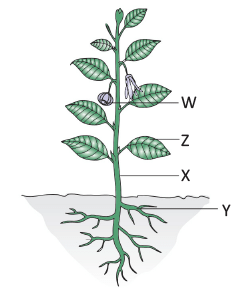 (a) In some plants, W plays no important role in reproduction, e.g., sugarcane.
(a) In some plants, W plays no important role in reproduction, e.g., sugarcane.
(b) In some plants, X is used for reproduction, e.g., rose.
(c) In some plants, Y is edible, e.g., cucumber.
(d) In some plants, Z is edible, e.g., cabbage.
 View Answer
View Answer 
Ans: (c)
The figure labels W as flower, X as stem, Y as root, and Z as leaf. The statement in option (c) claims that the root (Y) is edible in cucumber, which is incorrect because the edible part of the cucumber plant is the fruit, not the root.
Q35: Unscramble the provided letters to identify the term for the process of water soaking into the soil.
(a) VOEAPTOA1RN
(b) RCPIP11TETOAN
(c) FROILTNITAIN
(d) ONENCSDANIOT
 View Answer
View Answer 
Ans: (c)
- The correct term is "INFILTRATION," which describes how water moves from the surface into the soil.
- This process is essential for groundwater recharge and helps maintain the water cycle.
- Understanding infiltration is important for agriculture and environmental management.
- It plays a key role in preventing flooding and maintaining ecosystems.
Q36: Match the following items correctly:
(a) Apple
(b) Carrot
(c) Banana
(d) Broccoli
 View Answer
View Answer 
Ans: (a)
- Apple is a type of fruit, while Carrot, Banana, and Broccoli are vegetables.
- In this case, the correct match is Apple with its corresponding category.
- Understanding the classification of these items helps in identifying their nutritional benefits.
- Fruits like Apple are typically sweet and high in vitamins, while vegetables like Carrot and Broccoli are rich in fiber and minerals.
Q37: Refer to the following characteristics: (i) Existence of robust muscles. (ii) Existence of a swim bladder. (iii) Existence of paired and unpaired fins. Which of these characteristics assist fish in swimming through water?
(a) (i) and (ii) only
(b) (ii) and (iii) only
(c) (i) and (iii) only
(d) (i), (ii), and (iii)
 View Answer
View Answer 
Ans: (d)
- All the listed characteristics are essential for fish to swim effectively in water.
- Strong muscles provide the necessary power for movement.
- The swim bladder helps in buoyancy, allowing fish to maintain their depth.
- Paired and unpaired fins aid in steering and stability while swimming.
Q38: Which of the following statements is correct about the parts X and Y of seed?
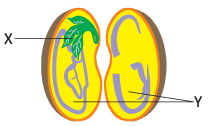 (a) The part X gives rise to the new plant.
(a) The part X gives rise to the new plant.
(b) The part Y gives nutrition to the young plant.
(c) The part Y gives rise to the new plant.
(d) Both (a) and (b)
 View Answer
View Answer 
Ans: (d)
Part X is the embryo (baby plant), which gives rise to the new plant, and part Y is the cotyledon (seed leaves), which provides nutrition to the young plant during early growth. Both statements (a) and (b) are correct, as the embryo develops into the new plant and the cotyledon supplies stored food.
Q39: The table below shows the parts of a germinating seedling and their functions.
Function:
(A) Supplies food
(B) Forms the root
(C) Forms leaves and stem
Which of the following combination is correct?
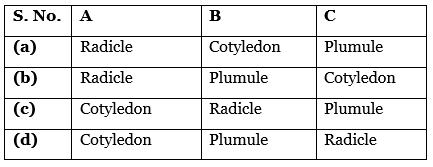
 View Answer
View Answer 
Ans: (c)
Cotyledons or seed leaves supply food, radicle forms the root and plumule forms leaves and stem.
Q41: Sonia spotted the seedling shown below growing on a sandy shore. Which of the following is the method by which the seed (which is now a seedling) was dispersed far away from its parent plant?
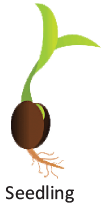 (a) By animals
(a) By animals
(b) By water
(c) By e xplosion
(d) None of these
 View Answer
View Answer 
Ans: (b)
The seedling was dispersed by water.
Q42: Which of the following statements incorrectly distinguishes between weaving and knitting?
(a) Weaving is performed by machines while knitting is exclusively done by hand.
(b) Weaving utilizes a single yarn, whereas knitting employs two sets of yarn.
(c) Weaving is limited to silk, while knitting is restricted to wool.
(d) (i), (ii), and (iii)
 View Answer
View Answer 
Ans: (d)
- All three statements are incorrect. Weaving can be accomplished using both handlooms and machines, not just machines. Knitting can also be done by hand or machine, so it is not limited to handwork only.
- Weaving typically uses multiple yarns woven together, while knitting uses a single yarn to create loops. Additionally, both techniques can be applied to various materials, not just silk or wool.
- Thus, the correct answer is (d) as all the provided statements are false.
Q43: Aadishree's teacher instructed her to categorize four groups of identical types of rocks. She created the following groups but erred in one. Find the error and choose the right option:
(a) Sandstone, Shale, Conglomerate
(b) Slate, Marble, Limestone
(c) Pumice, Granite, Obsidian
(d) Quartzite, Gneiss, Slate
 View Answer
View Answer 
Ans: (b)
- Slate and Marble are classified as metamorphic rocks, whereas Limestone is a sedimentary rock.
- The other groups consist of rocks that belong to the same category, making option (b) the incorrect grouping.
- Understanding rock types is essential for proper classification.
- Thus, the mistake lies in mixing different types of rocks in one group.
Q44: Three friends made the following statements about the muscles present in our body: Navya: Muscles P never take rest. They are found in the organs which do not function under our control. Aashvi: Muscles Q function under our control and are involved in the movement of the body. Jahanvi: Muscles R work on their own but can get fatigued. They are found in our heart.
(a) Navya only
(b) Aashvi and Jahanvi only
(c) Jahanvi only
(d) Navya and Jahanvi only
 View Answer
View Answer 
Ans: (b)
- Navya's statement about muscles P (involuntary muscles, likely smooth muscles) is correct, as they are found in organs like the stomach and intestines, which work involuntarily and continuously.
- Aashvi's statement about muscles Q (skeletal muscles) is correct, as they are voluntary and responsible for body movement.
- Jahanvi's statement about muscles R (cardiac muscles) is incorrect because cardiac muscles, found in the heart, do not get fatigued; they work continuously without tiring. However, the provided answer incorrectly states that Jahanvi's statement is correct. The correct answer should be (b), as Navya and Aashvi's statements are accurate, but Jahanvi's is not.
Q45: Amit set up an experiment as shown in the figures. In which petri-dish seeds would grow into seedlings successfully?
(a) 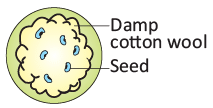
(b) 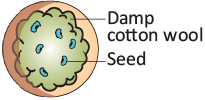
(c) 
(d) 
 View Answer
View Answer 
Ans: (a)
In petri-dish A, seeds would grow into seedlings successfully as it has all required factors for growth of the plant.
Achievers Section
Q46: The given diagram shows two plants X and Y. Select the correct option regarding the difference between the two. 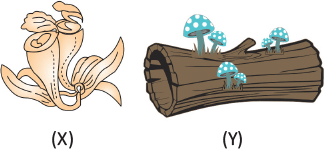 (a) Plant X can make its own food and Plant Y can partly make its own food.
(a) Plant X can make its own food and Plant Y can partly make its own food.
(b) Plant X cannot make its own food, but Plant Y can make its own food.
(c) Plant X depends partly on animals for food but can also make its own food while Plant Y cannot make its own food.
(d) Plant X cannot make its own food while Plant Y depends on decaying matter for food and can also make its own food.
 View Answer
View Answer 
Ans: (c)
Plant X depends partly on animals for food but can also make its own food while Y cannot make its own food.
Q47: Raman planted four plants P, Q , R and S near the boundary of his garden. The diagram shows the distribution of these plants in the garden area after a certain time period.
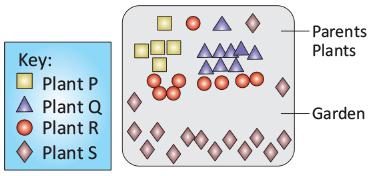 Which one of the plants is most likely to be Hiptage?
Which one of the plants is most likely to be Hiptage?
(a) Plant P
(b) Plant Q
(c) Plant R
(d) Plant S
 View Answer
View Answer 
Ans: (d)
Plant S is most likely to be Hiptage.
Q48: Shruti took a white carnation flower and split its stalk halfway along the length and arranged a set-up as shown in the given figure. After some time, she observed that half of the petals turned blue and half turned red. A section through stem also showed blue and red coloured areas.
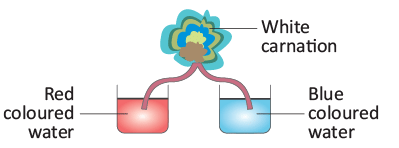 What can she infer from this experiment?
What can she infer from this experiment?
(a) stem conducts water to all plant parts.
(b) stem has localized structures for conduction of water.
(c) stem conducts solutes along with water.
(d) all of these.
 View Answer
View Answer 
Ans: (d)
All of these.
Q49: Which of the following is the correct statement regarding the different parts of a plant like seed, stem, leaf and spore?
(a) All rely on stored food for growth.
(b) All don’t need air, water and sunlight to grow.
(c) They all have to disperse for growth.
(d) They all can grow into new plant.
 View Answer
View Answer 
Ans:(d)
Plants can grow not only from seeds but also with the help of their roots, stems and leaves. The process by which new plants are grown from the parts of the plant other than seed is called vegetative propagation.
Q50: Which of the labelled parts would grow first, if the given seed germinates under the right conditions?
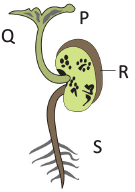
(a) P
(b) Q
(c) R
(d) S
 View Answer
View Answer 
Ans: (d)
Radicle grows first
|
70 videos|150 docs|104 tests
|
FAQs on Science Olympiad Previous Year Paper - 1 - Science Olympiad Class 6
| 1. What topics are covered in the Class 6 Science Olympiad exam? |  |
| 2. How can I prepare effectively for the Science Olympiad? |  |
| 3. What is the format of the Class 6 Science Olympiad exam? |  |
| 4. Are there any recommended books or resources for the Class 6 Science Olympiad preparation? |  |
| 5. How does the Science Olympiad benefit students? |  |

















